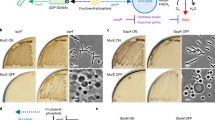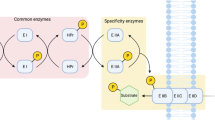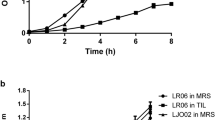Abstract
IT is acknowledged that in a large number of bacteria the main path for carbohydrate oxidation is the pentose phosphate cycle or other metabolic sequences not involving the Embden–Meyerhof pathway1. In the genus Pasteurella, work on P. pestis has shown that growing cells oxidize glucose through the pentose phosphate pathway2, but resting cells oxidize glucose through the combined action of glycolysis and the citric acid cycle3. In contrast with this metabolic duality, in P. multocida the pentose phosphate cycle is the main path for carbohydrate oxidation, both in growing and resting cells, and in regard to the citric acid cycle its principal role seems to be to supply carbon skeletons for the synthesis of amino-acids. These conclusions are borne out by experiments carried out with P. multocida (strain Beaufort No. 28 from the Institut Pasteur cultured aerobically for 4 hr. (growing cells) or 24 hr. (resting cells)) at 37° and pH. 7.2 in a medium made of meat extract, 5 gm. ; yeast extract (Difco), 1 gm. ; peptone, 30 gm.; sodium chloride, 5 gm.; glucose, 20 gm. ; agar, 25 gm. and water up to 1 litre. Our observations can be summarized as follows.
This is a preview of subscription content, access via your institution
Access options
Subscribe to this journal
Receive 51 print issues and online access
$199.00 per year
only $3.90 per issue
Buy this article
- Purchase on Springer Link
- Instant access to full article PDF
Prices may be subject to local taxes which are calculated during checkout
Similar content being viewed by others
References
Wood, H. G., Physiol. Revs., 35, 841 (1955). Elsden, S. R., and Peel, J. L., Ann. Rev. Microbiol, 12, 145 (1958).
Santer, M., and Ajl, S., J. Bact., 69, 713 (1955).
Santer, M., and Ajl, S., J. Bact., 69, 298 (1955). Englesberg, E., and Levy, J. B., J. Bact., 69, 418 (1955).
Korkes, S., Ann. Rev. Biochem., 25, 685 (1956).
Stoppani, A. O. M., Conches, L., de Favelukes, S. L. S., and Sacerdote, F. L., Biochem. J., 70, 438 (1958).
Horecker, B. L., and Smyrniotis, P. Z., J. Biol. Chem., 196, 135 (1952). Moses, V., Holm-Hansen, O., and Calvin, M., J. Bact., 77, 55 (1959).
Briefman, L., and Yaw, K. E., J. Bact., 75, 236 (1958). MacLennan, A. P., and Rondle, C. J. M., Nature, 180, 1045 (1957).
Author information
Authors and Affiliations
Rights and permissions
About this article
Cite this article
DE ISSALY, I., ISSALY, A. & STOPPANI, A. Role of the Pentose Phosphate Pathway in Pasteurella multocida. Nature 191, 727–728 (1961). https://doi.org/10.1038/191727b0
Issue Date:
DOI: https://doi.org/10.1038/191727b0
This article is cited by
Comments
By submitting a comment you agree to abide by our Terms and Community Guidelines. If you find something abusive or that does not comply with our terms or guidelines please flag it as inappropriate.



